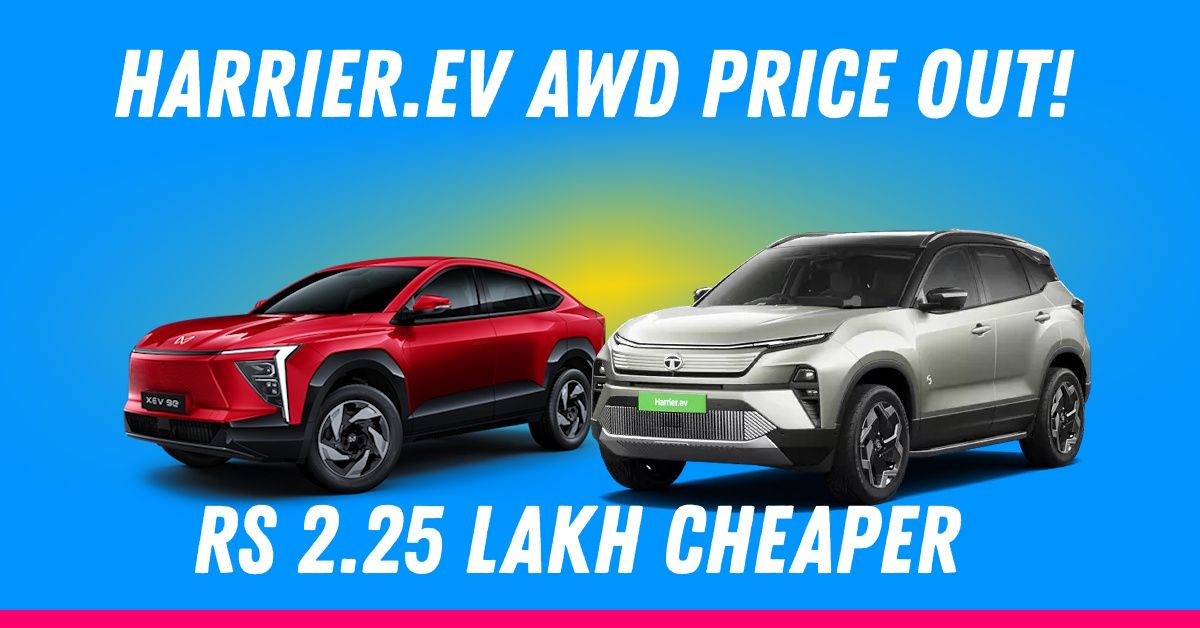Tata Harrier EV QWD (AWD) Rs 2.25 Lakh Cheaper Than Mahindra XUV 9e Top-End Variant (2WD)


The electric SUV battle in India just got more interesting with Tata's launch of the Harrier.ev QWD. This all-wheel-drive beast is taking direct aim at Mahindra's XUV 9e, and the competition is heating up. Let's dive into what makes each of these electric powerhouses tick and see which one deserves your hard-earned money[1][2][3][4].
Right off the bat, Tata has played smart with pricing. The Harrier.ev QWD comes in at ₹28.99 lakh, while the top-spec XUV 9e will set you back ₹31.25 lakh. That's a solid ₹2.25 lakh difference, which isn't pocket change for most buyers. But here's the kicker - you're actually getting more capability for less money with the Harrier. The winner is Harrier.ev, no doubt.
This is where the Harrier.ev QWD really flexes its muscles. Tata has equipped it with a dual-motor setup that churns out an impressive 396 PS of power and 504 Nm of torque. Compare that to the XUV 9e's single-motor rear-wheel-drive system producing 286 PS and 380 Nm, and you can see why the Harrier is making waves.
The numbers tell the story clearly. The Harrier delivers 38% more power and 33% more torque than its Mahindra rival. When you put your foot down, the Harrier rockets from 0 to 100 km/h in just 6.3 seconds, shaving off half a second compared to the XUV 9e's 6.8-second sprint.
But it's not just about straight-line speed. The Harrier's all-wheel-drive system gives it a massive advantage over the XUV 9e's rear-wheel-drive setup. Whether you're dealing with monsoon-soaked roads or planning a weekend adventure, that extra traction makes all the difference.
Both SUVs pack serious battery tech, though they take slightly different approaches. The Harrier uses a 75 kWh battery pack that delivers a claimed range of 622 km on the MIDC cycle. In real-world conditions, you can expect around 460-490 km, which is plenty for most users.
The XUV 9e counters with a larger 79 kWh battery and claims 656 km of range. That extra 34 km might sound appealing on paper, but remember - you're giving up all-wheel-drive capability for those extra kilometers.
Charging is where the Harrier shows its modern credentials. It can juice up from 20% to 80% in just 25 minutes using a 120 kW DC fast charger. The XEV 9e goes one step ahead with 175 kW DC fast charging. The Harrier pulls one back by offering Vehicle-to-Load functionality, meaning you can power your camping gear or even run household appliances during power cuts. The XEV 9e doesn't get V2L.
Tata has loaded the Harrier.ev QWD with a massive 14.53-inch Samsung Neo QLED infotainment screen that's crisp, responsive, and packed with features. The digital IRVM with dashcam recording is a neat touch that adds both convenience and security.
The Auto Park Assist system offers 15 different parking functions, making tight city spots less of a nightmare. For safety, Tata has included Level 2 ADAS with 22 features, giving you that extra peace of mind on highways and busy streets.
The digital key system supports three different technologies - UWB, NFC, and BLE - so you can unlock and start your car using your smartphone. It's the kind of feature that feels futuristic until you use it daily, then you wonder how you lived without it.
The Mahindra XEV 9e certainly has has an advantage when it comes to cool features, however. A massive triple screen layout is the first such feature to be seen on an Indian car. Glass sunroof, AR heads-up display, 165 speaker Harman Kardon system with Dolby Atmos are just a few cool features. Those who love futuristic tech as Indians understand the term are more likely to prefer the XEV 9E.
Here's where the Harrier.ev QWD really separates itself from the pack. It's the only all-wheel-drive electric SUV in its segment, and Tata hasn't just slapped on AWD for marketing purposes. The system comes with six terrain modes including Snow, Mud, Sand, and Rock Crawl.
The proof is in the pudding - or in this case, the 34-degree incline at Elephant Rock in Kerala that the Harrier conquered during testing. With 47% gradeability, this electric SUV can handle slopes that would leave many traditional SUVs struggling.
The XUV 9e, being rear-wheel-drive only, simply can't match this capability. If your adventures take you beyond paved roads, the choice becomes pretty clear.
When you step back and look at the complete picture, the Harrier.ev QWD emerges as the more compelling package. You're getting significantly more power, superior capability, advanced technology, and proven off-road credentials - all while saving over ₹2 lakh compared to the XUV 9e.
The XUV 9e isn't a bad SUV by any means. It offers competitive range and Mahindra's reputation for building tough vehicles. However, when faced with the Harrier's combination of performance, features, and value, it's hard to make a case for spending more money on less capability.
For buyers who want the most electric SUV for their money, the Harrier.ev QWD delivers on multiple fronts. It's powerful enough for highway overtakes, capable enough for weekend adventures, and tech-savvy enough for daily urban life. In a segment where every rupee counts, Tata has created a winner that's tough to beat.